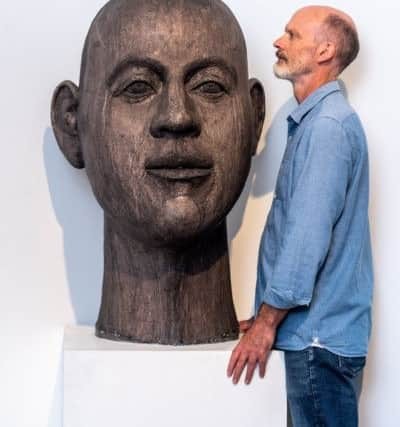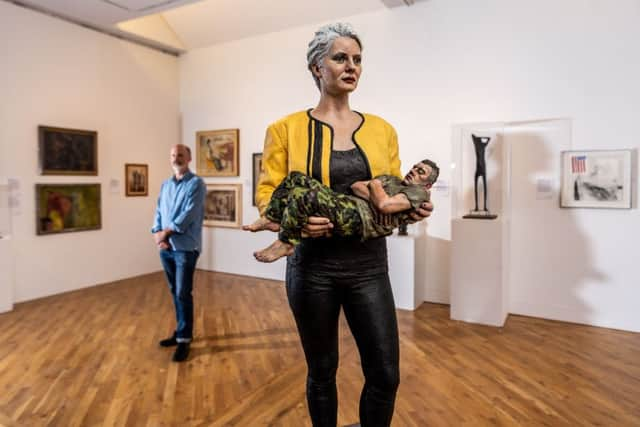British art in changing world under the spotlight at Hull’s Ferens Gallery
It was, admits James Russell, “a bit like being offered two of the very biggest boxes of chocolates that you can ever imagine, and being asked to pick your favourites. Or like being offered the keys to a sweet shop, and told that you could enjoy whatever you wanted from the shelves.” So when he was offered a chance like that, he jumped at it. Bristol-based James is an acclaimed writer, lecturer and art expert, and two years ago he got a call from Hull’s celebrated Ferens Art Gallery. Would he, they asked, like to think about putting together an exhibition which asked questions about identity and belonging, and what it means (if anything) to be British? How do artists and creatives present themselves to the world, and what do we make of their contribution?
Advertisement
Hide AdAdvertisement
Hide AdThe result is a spellbinding, provoking and hugely entertaining new presentation at the Ferens. Called Reflection: British Art in an Age of Change, it brings together over 130 very different works from the Ferens’ own collection and archives (“simply one of the very best in the UK, especially when it comes to modern British work”, says James), and the Ingram Collection. The Ingram (formed by “serial entrepreneur and philanthropist” Chris Ingram as recently as 2002) is now recognised as one of this country’s most significant and publicly accessible collections of modern British art. Currently, it has over 600 works – while the Ferens, nearly a century old – has many more. The Ferens is a much-loved Humberside institution. “It’s the sort of place,” says James, “where people can wander in from the street in their lunch hour, and just pick and choose what they want to see. The wonderful thing is that it is entirely free, and that people do have their favourite pictures and paintings, and they never seem to tire of them. Take Rosa Bonheur’s wonderful The Lion at Home down, for example, and put it into storage, and there would be a very loud protest indeed!”


Visitors in the coming months will discover two of the Ferens’ largest rooms filled with paintings, drawings and sculptures, on canvas and paper, and using as whole range of materials, from wood to bronze. In one corner – of course – is the iconic Sea of Hull, by Spencer Tunick, created during the recent City of Culture celebrations when 3,200 volunteer Hull folk stripped off and painted themselves blue, to be photographed out on the nearby pavements one chilly early July morning. It speaks volumes about the public-spiritedness of the city’s people, and their enjoyment of being part of a collective culture. In direct contrast – and this is where James shows his talent for arrangement and for contrast – is John Minton’s Deserted Garrison, which offers a rather bleak and sad Corsican square, drawn in ink in 1947. James’s gift is to juxtapose the startling with the uplifting – such as placing the monumental and rather scary canvas Resurrection (1999) alongside Keith Vaughan’s much smaller, uplifting and optimistic study for his vast Festival of Britain mural. From 1950, it is rare in being virtually the only survivor of the Festival’s planning stages.
James is a busy man, curating and lecturing for the Arts Society, and he also gives illustrated talks for arts organisations, festivals and museums, among them the V&A in London and the Friends of Leeds Art Gallery. He is now recognised as an expert in his field and is an out-and-out art enthusiast. “We were at the Ferens one afternoon, looking at all sorts of possibilities that could feature in Reflection, and, well, you know how it is, I became totally engrossed at the wealth of treasures in store. I’d lost all track of time, until it became clear that we were within seconds of being locked in overnight – the security people were just about to set the alarms and secure the doors. Mind you, I can think of far worse places to spend an evening. It was a real treat to put it all together, and so exciting when, just a couple of weeks ago, it finally all came together, and we hung and placed everything within about a week.”
There are surprises at every turn. It is often forgotten that Barbara Hepworth was a fine graphic artist, as well as a world-renowned sculptor, but here is one of her beautiful (almost architectural) studies. There are early works by Hockney. There’s a remarkable Edward Burra, a sensational account of the North York Moors near Whitby. Elisabeth Frink figures, as does Stanley Spencer and (perhaps surprisingly) Edmund Dulac, best known for his intricate book illustration, but here included for his 1922 portrait of Elizabeth Allhusen. There are old favourites, and some warm surprises – many will love the simple William Dring portrait of Private Coe (1941), with the young serviceman looking wistfully out of the frame, the slightest of smiles on his lips.


Advertisement
Hide AdAdvertisement
Hide AdJames’s own favourite, he says, is an Eric Ravilious, drawn just after the start of the Second World War, and titled Channel Fisher. It seems as if there are birds whirling about the vessel, but look closely, and you will find that they are in fact barrage balloons. “I particular warm to that painting, because of the composition, and the light he uses. It’s magical,” he adds.
James was, he says “basically given a free rein in what I could include. I want people to constantly ask questions – ‘Why is she dressed like that?’ ‘What is the story here?’ ‘Why is this painting next to that one?’ There are around one hundred artists represented, and I must have looked at, and considered, thousands. It’s been like doing a particularly tough puzzle. The joy is that there are works here which have hardly ever been seen before – just by the artist, and the curators. It really was treasure hunting, and there were a lot of ‘Wow!’ moments. Hard work, yes, but such a joy to pull it all together”.
Reflection: British Art in an Age of Change runs until January 5, next year. Admission free. www.hcandl.co.uk/ferens